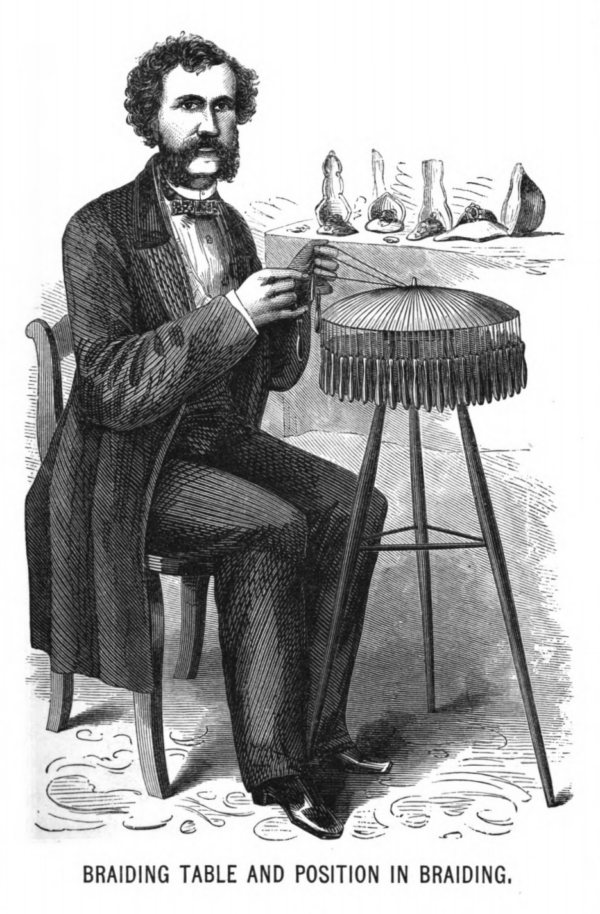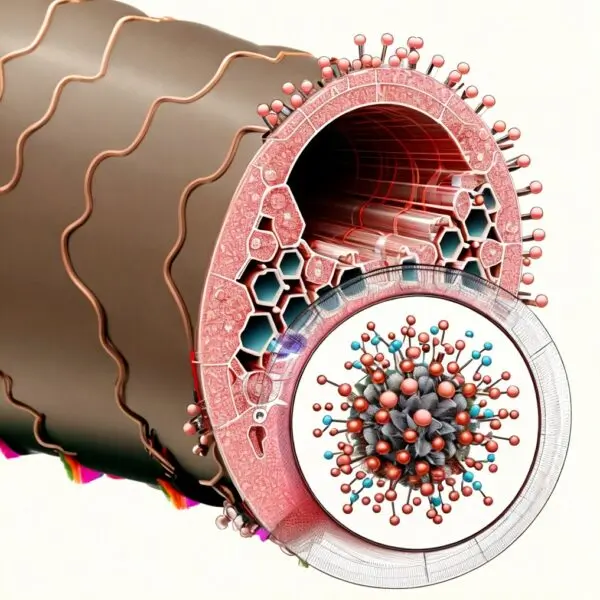The preservation of DNA in hair is a fascinating and complex topic, especially when considering its applications in fields like archaeology, paleontology, and forensic science. Hair has gained prominence as a substrate for ancient genomic analyses, mainly due to its potential for providing valuable genetic information. This article delves into the longevity of DNA in hair, examining various factors that influence DNA preservation, as well as the challenges and opportunities in extracting DNA from hair samples.
Understanding DNA Preservation in Hair : Deoxyribonucleic acids (abbreviated to DNA) are the molecules that carry genetic information for the development and functioning of an organism. Hair, being a hard keratinous material, offers a unique matrix for DNA preservation. Unlike bones, which require invasive methods for DNA extraction, hair provides a less destructive alternative. For human archaeological research, extracting DNA from hair is becoming much more important as ethical approval for destructive sampling is increasingly difficult to obtain. Standard DNA collection methods often involve breaking the skull to access petrous bone or sampling remaining teeth. Such DNA extraction approaches are becoming less and less acceptable for ethical, religious and cultural reasons.
A key aspect to consider in studying hair derived DNA is the distinction between mitochondrial DNA (mtDNA) and nuclear DNA (nDNA). For the most part, archeologists are most interested in obtaining nDNA as this is the DNA that contains the code for genes that define a person (their hair color, height, eye color, etc.). While mtDNA is abundant in hair shafts, the presence of nDNA is significantly lower and more variable. The location of nDNA within hair shafts is still a subject of debate among researchers. Some suggest it is only present in the outer layer (cuticle), while others argue for its presence in both the cortex and the cuticle. Different research studies provide conflicting data in support of both opinions; more studies on a larger scale are really needed to put the argument to rest.
Factors Affecting DNA Longevity in Hair : What is known with confidence is that the survival of DNA in hair is influenced by multiple factors, with environmental conditions playing a crucial role. Contrary to common belief, the age of the hair sample is not the primary determinant of DNA preservation. Instead, the depositional environment from which the hairs are retrieved is a much more critical factor. For instance, hair samples taken from animals preserved in arctic permafrost have shown successful DNA extraction. The age of the samples even exceeded the limits of radiocarbon dating (over 50,000 years old).
For human bodies, hairs collected from Siberian mummies dating from the 16th Century, and Greenland Qilakitsoq Inuit mummies from the 15th Century, have provided DNA for research. Rather intriguingly, one study has shown that DNA can be protected by the cement that glues head lice nits to the hair of ancient mummies and the researchers used this phenomena to successfully isolate DNA from cells trapped in the cement from the hair of 1,500-2,000 year old Argentinian mummies. As research methods continue to improve, it is likely that DNA will be successfully isolated from even older human hair samples in the future.
In contrast, hair samples from younger “bog bodies” (human bodies submerged in peat bog land) have repeatedly failed to yield DNA. This may be due to the accelerated degradation of DNA that occurs in moist environments, or contamination with substances that inhibit polymerase chain reaction (PCR) procedures (the laboratory method used by scientists to Process DNA), like the humic acids found in peat earth.
Challenges in DNA Extraction and Analysis : Extracting and analyzing DNA from hair shafts poses several challenges. The variable levels of nDNA in hair make it difficult to predict the success of DNA extraction. Moreover, environmental factors such as microbial attack or exposure to inhibitors can further complicate the process. Microbes can have their own DNA which contaminates the hair sample, and they may also accelerate the breakdown of DNA in the hair as part of the disintegration process. The integrity of the DNA is a concern, as fragmentation and chemical modifications over time can hinder analysis.
Research and Technological Advances : The field of ancient DNA research is rapidly evolving, with new technologies and methodologies enhancing our ability to extract and analyze DNA from hair. Next-generation sequencing techniques are particularly promising, allowing for more comprehensive genomic analyses even from degraded DNA samples. Furthermore, advancements in bioinformatics are aiding in the interpretation of ancient DNA data, providing insights into the evolutionary history and genetic diversity of species, including humans.
Practical Implications : The ability to extract and analyze DNA from hair has significant implications in various fields. In archaeology and paleontology, it enables the study of ancient populations and extinct species, offering a window into the past. In forensic science, hair DNA can be a critical piece of evidence in criminal investigations. Understanding the factors that influence DNA preservation in hair can also aid in developing better storage and conservation practices for biological samples.
Future Directions and Research : Future research in this area could focus on better understanding the mechanisms of DNA preservation in hair. Exploring ways to enhance DNA extraction from difficult samples, and developing more robust methods for analyzing degraded DNA would help. Such research would not only expand our knowledge of ancient genomics, but also improve the practical applications of hair DNA analysis in various scientific fields.
Conclusions : It’s clear that the longevity of DNA in hair is influenced by a complex interplay of biological and environmental factors. While the preservation of mtDNA in hair shafts is relatively well established, the dynamics of nDNA preservation are much less clear. The depositional environment in which the hair sample is preserved plays a more significant role in DNA conservation than the age of the hair itself. As research in this field continues to advance, our understanding of DNA preservation in hair will deepen, opening new avenues for exploration in both historical and modern contexts.
Bibliography
11711645 {11711645:J2XV7URJ},{11711645:DXGS2DCP},{11711645:3MHBSTR5},{11711645:X8R49GSD},{11711645:V8UVXI6F},{11711645:Z93M84QS},{11711645:5R9BKFDK},{11711645:PU734XFQ},{11711645:ZUP5TH9D},{11711645:Q759ISRD},{11711645:EFWF9K39} 1 vancouver 50 date asc 664 https://www.keratin.com/wp-content/plugins/zotpress/ %7B%22status%22%3A%22success%22%2C%22updateneeded%22%3Afalse%2C%22instance%22%3Afalse%2C%22meta%22%3A%7B%22request_last%22%3A0%2C%22request_next%22%3A0%2C%22used_cache%22%3Atrue%7D%2C%22data%22%3A%5B%7B%22key%22%3A%223MHBSTR5%22%2C%22library%22%3A%7B%22id%22%3A11711645%7D%2C%22meta%22%3A%7B%22creatorSummary%22%3A%22Burger%20et%20al.%22%2C%22parsedDate%22%3A%221999-06%22%2C%22numChildren%22%3A0%7D%2C%22bib%22%3A%22%3Cdiv%20class%3D%5C%22csl-bib-body%5C%22%20style%3D%5C%22line-height%3A%201.35%3B%20%5C%22%3E%5Cn%20%20%3Cdiv%20class%3D%5C%22csl-entry%5C%22%20style%3D%5C%22clear%3A%20left%3B%20%5C%22%3E%5Cn%20%20%20%20%3Cdiv%20class%3D%5C%22csl-left-margin%5C%22%20style%3D%5C%22float%3A%20left%3B%20padding-right%3A%200.5em%3B%20text-align%3A%20right%3B%20width%3A%201em%3B%5C%22%3E1.%3C%5C%2Fdiv%3E%3Cdiv%20class%3D%5C%22csl-right-inline%5C%22%20style%3D%5C%22margin%3A%200%20.4em%200%201.5em%3B%5C%22%3EBurger%20J%2C%20Hummel%20S%2C%20Hermann%20B%2C%20Henke%20W.%20DNA%20preservation%3A%20a%20microsatellite-DNA%20study%20on%20ancient%20skeletal%20remains.%20Electrophoresis.%201999%20Jun%3B20%288%29%3A1722%26%23x2013%3B8.%3C%5C%2Fdiv%3E%5Cn%20%20%20%3C%5C%2Fdiv%3E%5Cn%3C%5C%2Fdiv%3E%22%2C%22data%22%3A%7B%22itemType%22%3A%22journalArticle%22%2C%22title%22%3A%22DNA%20preservation%3A%20a%20microsatellite-DNA%20study%20on%20ancient%20skeletal%20remains%22%2C%22creators%22%3A%5B%7B%22creatorType%22%3A%22author%22%2C%22firstName%22%3A%22J.%22%2C%22lastName%22%3A%22Burger%22%7D%2C%7B%22creatorType%22%3A%22author%22%2C%22firstName%22%3A%22S.%22%2C%22lastName%22%3A%22Hummel%22%7D%2C%7B%22creatorType%22%3A%22author%22%2C%22firstName%22%3A%22B.%22%2C%22lastName%22%3A%22Hermann%22%7D%2C%7B%22creatorType%22%3A%22author%22%2C%22firstName%22%3A%22W.%22%2C%22lastName%22%3A%22Henke%22%7D%5D%2C%22abstractNote%22%3A%22To%20determine%20the%20effect%20of%20environmental%20factors%20on%20the%20preservation%20of%20DNA%2C%20archeological%20teeth%20of%20approximately%20similar%20age%20but%20greatly%20differing%20site%20milieu%20were%20examined%20for%20DNA%20content.%20The%20complex%20relational%20system%20of%20locational%20milieu%20of%20the%20samples%20was%20reduced%20to%20its%20essential%20and%2C%20at%20the%20same%20time%2C%20easily%20measurable%20factors.%20These%20are%20temperature%2C%20humidity%2C%20pH%20value%2C%20the%20geochemical%20properties%20of%20the%20soil%2C%20the%20amount%20of%20postmortal%20organic%20substances%20and%20the%20general%20degree%20of%20microbial%20infestation%20in%20the%20respective%20soil.%20The%20relative%20DNA%20content%20in%20the%20samples%20was%20established%20by%20determining%20the%20rate%20of%20successful%20polymerase%20chain%20reaction%20%28PCR%29%20amplifications.%20Differences%20in%20quantity%20and%20quality%20of%20the%20results%20are%20attributed%20to%20the%20respective%20prevailing%20environmental%20factor%20or%20to%20the%20respective%20storage%20conditions.%20Dryness%2C%20low%20temperature%20and%20absence%20of%20microorganisms%20favors%20the%20preservation%20of%20DNA.%20The%20bioapatite%20of%20bones%20and%20teeth%2C%20like%20the%20DNA%2C%20are%20preserved%20under%20neutral%20or%20slightly%20alkaline%20conditions.%20Brief%20storage%20at%20room%20temperature%20does%20not%20affect%20the%20amount%20of%20amplifiable%20DNA%20but%20does%20affect%20the%20reproducibility%20of%20the%20results.%20Long%20storage%20outside%20a%20lab%20freezer%20reduces%20the%20amount%20and%20the%20reproducibility%20of%20DNA%20amplifications%20in%20ancient%20specimens.%22%2C%22date%22%3A%221999-06%22%2C%22language%22%3A%22eng%22%2C%22DOI%22%3A%2210.1002%5C%2F%28SICI%291522-2683%2819990101%2920%3A8%3C1722%3A%3AAID-ELPS1722%3E3.0.CO%3B2-4%22%2C%22ISSN%22%3A%220173-0835%22%2C%22url%22%3A%22%22%2C%22collections%22%3A%5B%224WIP3XH4%22%5D%2C%22dateModified%22%3A%222023-12-05T17%3A38%3A28Z%22%7D%7D%2C%7B%22key%22%3A%22Q759ISRD%22%2C%22library%22%3A%7B%22id%22%3A11711645%7D%2C%22meta%22%3A%7B%22creatorSummary%22%3A%22McNevin%20et%20al.%22%2C%22parsedDate%22%3A%222005-10-29%22%2C%22numChildren%22%3A0%7D%2C%22bib%22%3A%22%3Cdiv%20class%3D%5C%22csl-bib-body%5C%22%20style%3D%5C%22line-height%3A%201.35%3B%20%5C%22%3E%5Cn%20%20%3Cdiv%20class%3D%5C%22csl-entry%5C%22%20style%3D%5C%22clear%3A%20left%3B%20%5C%22%3E%5Cn%20%20%20%20%3Cdiv%20class%3D%5C%22csl-left-margin%5C%22%20style%3D%5C%22float%3A%20left%3B%20padding-right%3A%200.5em%3B%20text-align%3A%20right%3B%20width%3A%201em%3B%5C%22%3E1.%3C%5C%2Fdiv%3E%3Cdiv%20class%3D%5C%22csl-right-inline%5C%22%20style%3D%5C%22margin%3A%200%20.4em%200%201.5em%3B%5C%22%3EMcNevin%20D%2C%20Wilson-Wilde%20L%2C%20Robertson%20J%2C%20Kyd%20J%2C%20Lennard%20C.%20Short%20tandem%20repeat%20%28STR%29%20genotyping%20of%20keratinised%20hair.%20Part%201.%20Review%20of%20current%20status%20and%20knowledge%20gaps.%20Forensic%20Sci%20Int.%202005%20Oct%2029%3B153%282%26%23x2013%3B3%29%3A237%26%23x2013%3B46.%3C%5C%2Fdiv%3E%5Cn%20%20%20%3C%5C%2Fdiv%3E%5Cn%3C%5C%2Fdiv%3E%22%2C%22data%22%3A%7B%22itemType%22%3A%22journalArticle%22%2C%22title%22%3A%22Short%20tandem%20repeat%20%28STR%29%20genotyping%20of%20keratinised%20hair.%20Part%201.%20Review%20of%20current%20status%20and%20knowledge%20gaps%22%2C%22creators%22%3A%5B%7B%22creatorType%22%3A%22author%22%2C%22firstName%22%3A%22Dennis%22%2C%22lastName%22%3A%22McNevin%22%7D%2C%7B%22creatorType%22%3A%22author%22%2C%22firstName%22%3A%22Linzi%22%2C%22lastName%22%3A%22Wilson-Wilde%22%7D%2C%7B%22creatorType%22%3A%22author%22%2C%22firstName%22%3A%22James%22%2C%22lastName%22%3A%22Robertson%22%7D%2C%7B%22creatorType%22%3A%22author%22%2C%22firstName%22%3A%22Jennelle%22%2C%22lastName%22%3A%22Kyd%22%7D%2C%7B%22creatorType%22%3A%22author%22%2C%22firstName%22%3A%22Chris%22%2C%22lastName%22%3A%22Lennard%22%7D%5D%2C%22abstractNote%22%3A%22We%20present%20a%20review%20of%20the%20literature%20on%20procedures%20for%20obtaining%20short%20tandem%20repeat%20%28STR%29%20genotypes%20from%20keratinised%20hair%2C%20being%20either%20hair%20shaft%20or%20telogen%20phase%20%28naturally%20shed%29%20hairs%20without%20associated%20scalp%2C%20follicle%20or%20sheath%20cells.%20Both%20the%20hair%20shaft%20and%20the%20telogen%20hair%20club%20have%20been%20subjected%20to%20the%20DNA-degrading%20keratinisation%20process%20and%20are%20more%20likely%20to%20be%20found%20at%20a%20crime%20scene%20than%20anagen%20%28plucked%29%20or%20catagen%20phase%20hairs.%20We%20discuss%20human%20hair%20structure%2C%20the%20human%20hair%20growth%20cycle%2C%20the%20keratinisation%20process%20and%20their%20implications%20for%20DNA%20extraction%20procedures%2C%20PCR%20amplification%20strategies%20and%20the%20interpretation%20of%20STR%20genotypes.%20Knowledge%20gaps%20and%20areas%20requiring%20research%20are%20identified%20and%20are%20the%20subject%20of%20a%20second%20article%20in%20this%20series.%22%2C%22date%22%3A%222005-10-29%22%2C%22language%22%3A%22eng%22%2C%22DOI%22%3A%2210.1016%5C%2Fj.forsciint.2005.05.006%22%2C%22ISSN%22%3A%220379-0738%22%2C%22url%22%3A%22%22%2C%22collections%22%3A%5B%224WIP3XH4%22%5D%2C%22dateModified%22%3A%222023-12-05T17%3A36%3A51Z%22%7D%7D%2C%7B%22key%22%3A%22ZUP5TH9D%22%2C%22library%22%3A%7B%22id%22%3A11711645%7D%2C%22meta%22%3A%7B%22creatorSummary%22%3A%22McNevin%20et%20al.%22%2C%22parsedDate%22%3A%222005-10-29%22%2C%22numChildren%22%3A0%7D%2C%22bib%22%3A%22%3Cdiv%20class%3D%5C%22csl-bib-body%5C%22%20style%3D%5C%22line-height%3A%201.35%3B%20%5C%22%3E%5Cn%20%20%3Cdiv%20class%3D%5C%22csl-entry%5C%22%20style%3D%5C%22clear%3A%20left%3B%20%5C%22%3E%5Cn%20%20%20%20%3Cdiv%20class%3D%5C%22csl-left-margin%5C%22%20style%3D%5C%22float%3A%20left%3B%20padding-right%3A%200.5em%3B%20text-align%3A%20right%3B%20width%3A%201em%3B%5C%22%3E1.%3C%5C%2Fdiv%3E%3Cdiv%20class%3D%5C%22csl-right-inline%5C%22%20style%3D%5C%22margin%3A%200%20.4em%200%201.5em%3B%5C%22%3EMcNevin%20D%2C%20Wilson-Wilde%20L%2C%20Robertson%20J%2C%20Kyd%20J%2C%20Lennard%20C.%20Short%20tandem%20repeat%20%28STR%29%20genotyping%20of%20keratinised%20hair.%20Part%202.%20An%20optimised%20genomic%20DNA%20extraction%20procedure%20reveals%20donor%20dependence%20of%20STR%20profiles.%20Forensic%20Sci%20Int.%202005%20Oct%2029%3B153%282%26%23x2013%3B3%29%3A247%26%23x2013%3B59.%3C%5C%2Fdiv%3E%5Cn%20%20%20%3C%5C%2Fdiv%3E%5Cn%3C%5C%2Fdiv%3E%22%2C%22data%22%3A%7B%22itemType%22%3A%22journalArticle%22%2C%22title%22%3A%22Short%20tandem%20repeat%20%28STR%29%20genotyping%20of%20keratinised%20hair.%20Part%202.%20An%20optimised%20genomic%20DNA%20extraction%20procedure%20reveals%20donor%20dependence%20of%20STR%20profiles%22%2C%22creators%22%3A%5B%7B%22creatorType%22%3A%22author%22%2C%22firstName%22%3A%22Dennis%22%2C%22lastName%22%3A%22McNevin%22%7D%2C%7B%22creatorType%22%3A%22author%22%2C%22firstName%22%3A%22Linzi%22%2C%22lastName%22%3A%22Wilson-Wilde%22%7D%2C%7B%22creatorType%22%3A%22author%22%2C%22firstName%22%3A%22James%22%2C%22lastName%22%3A%22Robertson%22%7D%2C%7B%22creatorType%22%3A%22author%22%2C%22firstName%22%3A%22Jennelle%22%2C%22lastName%22%3A%22Kyd%22%7D%2C%7B%22creatorType%22%3A%22author%22%2C%22firstName%22%3A%22Chris%22%2C%22lastName%22%3A%22Lennard%22%7D%5D%2C%22abstractNote%22%3A%22A%20feasibility%20study%20of%20short%20tandem%20repeat%20%28STR%29%20genotyping%20of%20telogen%20phase%20hairs%20in%20particular%2C%20and%20hair%20shaft%20in%20general%2C%20is%20presented.%20A%20number%20of%20extraction%20procedures%20in%20common%20use%20were%20investigated%20and%20the%20quantities%20of%20nuclear%20DNA%20%28nuDNA%29%20delivered%20were%20quantified%20via%20a%20real-time%20PCR%20assay.%20The%20extracts%20were%20subjected%20to%20two%20variations%20on%20AmpFlSTR%20Profiler%20Plus%20PCR%20amplification%20strategies%20%28extended%20cycles%2C%20two%20rounds%20of%20PCR%29%20and%20the%20genotypes%20compared.%20Nuclear%20DNA%20was%20found%20to%20persist%20in%20human%20hair%20shafts%2C%20albeit%20at%20very%20low%20levels.%20Full%20Profiler%20Plus%20profiles%20consistent%20with%20the%20hair%20donor%20were%20obtained%20from%20100%20mg%20hair%20shaft%20samples%20%28bleached%20and%20unbleached%29.%20These%20were%2C%20however%2C%20mixed%20profiles%2C%20indicating%20low%20copy%20number%20%28LCN%29%20contamination%20in%20the%20extracts.%20Single%20telogen%20hair%20clubs%20and%20single%20hair%20shafts%20delivered%20partial%20profiles%20with%20usually%20only%20one%20allele%20of%20heterozygous%20loci.%20Telogen%20phase%20hairs%20yielded%20the%20same%20amount%20of%20nuDNA%20%28and%20no%20more%29%20as%20hair%20shafts%20%28either%20anagen%20or%20telogen%29.%20Whether%20hair%20shafts%20dissolved%20or%20not%20in%20lysis%20buffer%20had%20no%20effect%20on%20either%20the%20quantitated%20yield%20of%20DNA%20or%20on%20the%20chance%20of%20obtaining%20a%20correct%20genotype.%20These%20results%20provide%20evidence%20that%20genomic%20DNA%20resides%20on%20the%20exterior%20of%20the%20hair%20shaft%20and%20we%20use%20this%20information%20to%20suggest%20an%20optimal%20procedure%20for%20nuDNA%20extraction%20from%20keratinised%20hair%20samples%3A%20soaking%20hairs%20in%20simple%20digestion%20buffers%20containing%20Tris-HCl%2C%20a%20salt%20and%20a%20chelating%20agent%20without%20prior%20cleaning%20of%20the%20hair%20shafts.%20It%20is%20proposed%20that%20cleaning%20removes%20most%20of%20the%20recoverable%20DNA.%20This%20procedure%20was%20applied%20to%20obtain%20genotypes%20from%203%20cm%20hair%20shafts%20which%20matched%20reference%20profiles%20from%20the%20donors%20at%20up%20to%209%20out%20of%2010%20AmpFlSTR%20Profiler%20Plus%20STR%20loci.%20When%20the%20genotyping%20success%20was%20measured%20by%20counting%20the%20number%20of%20matches%20between%20the%20two%20dominant%20alleles%20at%20each%20locus%20for%20each%20extract%20with%20the%20reference%20DNA%20profile%20of%20the%20hair%20donor%2C%20the%20success%20was%20found%20to%20be%20highly%20dependent%20on%20the%20donor.%20The%20number%20of%20matching%20alleles%20varied%20between%20not%20less%20than%2010%20for%20one%20donor%20to%20no%20more%20than%20two%20for%20another%20donor.%20These%20results%20may%20well%20be%20linked%20to%20the%20environmental%20experience%20of%20the%20hairs%20from%20each%20donor%20prior%20to%20removal.%22%2C%22date%22%3A%222005-10-29%22%2C%22language%22%3A%22eng%22%2C%22DOI%22%3A%2210.1016%5C%2Fj.forsciint.2005.05.005%22%2C%22ISSN%22%3A%220379-0738%22%2C%22url%22%3A%22%22%2C%22collections%22%3A%5B%224WIP3XH4%22%5D%2C%22dateModified%22%3A%222023-12-05T17%3A37%3A04Z%22%7D%7D%2C%7B%22key%22%3A%22J2XV7URJ%22%2C%22library%22%3A%7B%22id%22%3A11711645%7D%2C%22meta%22%3A%7B%22creatorSummary%22%3A%22Amory%20et%20al.%22%2C%22parsedDate%22%3A%222007-03-02%22%2C%22numChildren%22%3A0%7D%2C%22bib%22%3A%22%3Cdiv%20class%3D%5C%22csl-bib-body%5C%22%20style%3D%5C%22line-height%3A%201.35%3B%20%5C%22%3E%5Cn%20%20%3Cdiv%20class%3D%5C%22csl-entry%5C%22%20style%3D%5C%22clear%3A%20left%3B%20%5C%22%3E%5Cn%20%20%20%20%3Cdiv%20class%3D%5C%22csl-left-margin%5C%22%20style%3D%5C%22float%3A%20left%3B%20padding-right%3A%200.5em%3B%20text-align%3A%20right%3B%20width%3A%201em%3B%5C%22%3E1.%3C%5C%2Fdiv%3E%3Cdiv%20class%3D%5C%22csl-right-inline%5C%22%20style%3D%5C%22margin%3A%200%20.4em%200%201.5em%3B%5C%22%3EAmory%20S%2C%20Keyser%20C%2C%20Crub%26%23xE9%3Bzy%20E%2C%20Ludes%20B.%20STR%20typing%20of%20ancient%20DNA%20extracted%20from%20hair%20shafts%20of%20Siberian%20mummies.%20Forensic%20Sci%20Int.%202007%20Mar%202%3B166%282%26%23x2013%3B3%29%3A218%26%23x2013%3B29.%3C%5C%2Fdiv%3E%5Cn%20%20%20%3C%5C%2Fdiv%3E%5Cn%3C%5C%2Fdiv%3E%22%2C%22data%22%3A%7B%22itemType%22%3A%22journalArticle%22%2C%22title%22%3A%22STR%20typing%20of%20ancient%20DNA%20extracted%20from%20hair%20shafts%20of%20Siberian%20mummies%22%2C%22creators%22%3A%5B%7B%22creatorType%22%3A%22author%22%2C%22firstName%22%3A%22S.%22%2C%22lastName%22%3A%22Amory%22%7D%2C%7B%22creatorType%22%3A%22author%22%2C%22firstName%22%3A%22C.%22%2C%22lastName%22%3A%22Keyser%22%7D%2C%7B%22creatorType%22%3A%22author%22%2C%22firstName%22%3A%22E.%22%2C%22lastName%22%3A%22Crub%5Cu00e9zy%22%7D%2C%7B%22creatorType%22%3A%22author%22%2C%22firstName%22%3A%22B.%22%2C%22lastName%22%3A%22Ludes%22%7D%5D%2C%22abstractNote%22%3A%22The%20aim%20of%20this%20study%20was%20to%20determine%20if%20ancient%20hair%20shafts%20could%20be%20suitable%20for%20nuclear%20DNA%20analysis%20and%20to%20develop%20an%20efficient%20and%20straightforward%20protocol%20for%20DNA%20extraction%20and%20STR%20typing%20of%20ancient%20specimens.%20The%20developed%20method%20was%20validated%20on%20modern%20and%20forensic%20samples%20and%20then%20successfully%20applied%20on%20ancient%20hairs%20collected%20from%20Siberian%20mummies%20dating%20from%20the%2016th%20to%20the%20early%2019th%20centuries.%20In%20parallel%20extractions%20including%20or%20excluding%20a%20washing%20step%20were%20performed%20at%20least%20two%20times%20for%20each%20sample%20in%20order%20to%20evaluate%20the%20influence%20on%20the%20quantity%20of%20nuclear%20DNA%20yielded%20and%20on%20the%20typing%20efficiency.%20Twelve%20ancient%20individuals%20were%20analyzed%20through%20our%20approach%20and%20full%20and%20reliable%20profiles%20were%20obtained%20for%20four%20of%20them.%20These%20profiles%20were%20validated%20by%20comparison%20with%20those%20obtained%20from%20bone%20and%20teeth%20DNA%20extracted%20from%20the%20same%20ancient%20specimens.%20The%20present%20study%20demonstrates%20that%20the%20washing%20step%20cannot%20be%20considered%20as%20deleterious%20for%20DNA%20retrieval%20since%20the%20same%20results%20were%20obtained%20by%20the%20two%20approaches.%20This%20finding%20challenges%20the%20hypothesis%20that%20recoverable%20nuclear%20DNA%20is%20only%20found%20on%20the%20outer%20surface%20of%20hair%20shafts%20and%20provides%20evidence%20that%20nuclear%20DNA%20can%20be%20successfully%20extracted%20from%20ancient%20hair%20shafts.%20The%20method%20described%20here%20constitutes%20a%20promising%20way%20for%20non-invasive%20investigations%20in%20ancient%20DNA%20analysis%20for%20precious%20or%20historical%20samples%20as%20well%20as%20forensic%20casework%20analyses.%22%2C%22date%22%3A%222007-03-02%22%2C%22language%22%3A%22eng%22%2C%22DOI%22%3A%2210.1016%5C%2Fj.forsciint.2006.05.042%22%2C%22ISSN%22%3A%220379-0738%22%2C%22url%22%3A%22%22%2C%22collections%22%3A%5B%224WIP3XH4%22%5D%2C%22dateModified%22%3A%222023-12-05T17%3A37%3A37Z%22%7D%7D%2C%7B%22key%22%3A%22Z93M84QS%22%2C%22library%22%3A%7B%22id%22%3A11711645%7D%2C%22meta%22%3A%7B%22creatorSummary%22%3A%22Gilbert%20et%20al.%22%2C%22parsedDate%22%3A%222007-06%22%2C%22numChildren%22%3A0%7D%2C%22bib%22%3A%22%3Cdiv%20class%3D%5C%22csl-bib-body%5C%22%20style%3D%5C%22line-height%3A%201.35%3B%20%5C%22%3E%5Cn%20%20%3Cdiv%20class%3D%5C%22csl-entry%5C%22%20style%3D%5C%22clear%3A%20left%3B%20%5C%22%3E%5Cn%20%20%20%20%3Cdiv%20class%3D%5C%22csl-left-margin%5C%22%20style%3D%5C%22float%3A%20left%3B%20padding-right%3A%200.5em%3B%20text-align%3A%20right%3B%20width%3A%201em%3B%5C%22%3E1.%3C%5C%2Fdiv%3E%3Cdiv%20class%3D%5C%22csl-right-inline%5C%22%20style%3D%5C%22margin%3A%200%20.4em%200%201.5em%3B%5C%22%3EGilbert%20MTP%2C%20Djurhuus%20D%2C%20Melchior%20L%2C%20Lynnerup%20N%2C%20Worobey%20M%2C%20Wilson%20AS%2C%20et%20al.%20mtDNA%20from%20hair%20and%20nail%20clarifies%20the%20genetic%20relationship%20of%20the%2015th%20century%20Qilakitsoq%20Inuit%20mummies.%20Am%20J%20Phys%20Anthropol.%202007%20Jun%3B133%282%29%3A847%26%23x2013%3B53.%3C%5C%2Fdiv%3E%5Cn%20%20%20%3C%5C%2Fdiv%3E%5Cn%3C%5C%2Fdiv%3E%22%2C%22data%22%3A%7B%22itemType%22%3A%22journalArticle%22%2C%22title%22%3A%22mtDNA%20from%20hair%20and%20nail%20clarifies%20the%20genetic%20relationship%20of%20the%2015th%20century%20Qilakitsoq%20Inuit%20mummies%22%2C%22creators%22%3A%5B%7B%22creatorType%22%3A%22author%22%2C%22firstName%22%3A%22M.%20Thomas%20P.%22%2C%22lastName%22%3A%22Gilbert%22%7D%2C%7B%22creatorType%22%3A%22author%22%2C%22firstName%22%3A%22Durita%22%2C%22lastName%22%3A%22Djurhuus%22%7D%2C%7B%22creatorType%22%3A%22author%22%2C%22firstName%22%3A%22Linea%22%2C%22lastName%22%3A%22Melchior%22%7D%2C%7B%22creatorType%22%3A%22author%22%2C%22firstName%22%3A%22Niels%22%2C%22lastName%22%3A%22Lynnerup%22%7D%2C%7B%22creatorType%22%3A%22author%22%2C%22firstName%22%3A%22Michael%22%2C%22lastName%22%3A%22Worobey%22%7D%2C%7B%22creatorType%22%3A%22author%22%2C%22firstName%22%3A%22Andrew%20S.%22%2C%22lastName%22%3A%22Wilson%22%7D%2C%7B%22creatorType%22%3A%22author%22%2C%22firstName%22%3A%22Claus%22%2C%22lastName%22%3A%22Andreasen%22%7D%2C%7B%22creatorType%22%3A%22author%22%2C%22firstName%22%3A%22J%5Cu00f8rgen%22%2C%22lastName%22%3A%22Dissing%22%7D%5D%2C%22abstractNote%22%3A%22The%2015th%20century%20Inuit%20mummies%20excavated%20at%20Qilakitsoq%20in%20Greenland%20in%201978%20were%20exceptionally%20well%20preserved%20and%20represent%20the%20largest%20find%20of%20naturally%20mummified%20specimens%20from%20the%20Arctic.%20The%20estimated%20ages%20of%20the%20individuals%2C%20their%20distribution%20between%20two%20adjacent%20graves%2C%20the%20results%20of%20tissue%20typing%2C%20and%20incomplete%20STR%20results%20led%20researchers%20to%20conclude%20that%20the%20eight%20mummies%20formed%20two%20distinct%20family%20groups%3A%20A%20grandmother%20%28I%5C%2F5%29%2C%20two%20daughters%20%28I%5C%2F3%2C%20I%5C%2F4%29%2C%20and%20their%20two%20children%20%28I%5C%2F1%2C%20I%5C%2F2%29%20in%20one%20grave%2C%20and%20two%20sisters%20%28II%5C%2F6%2C%20II%5C%2F8%29%20and%20a%20daughter%20%28II%5C%2F7%29%20of%20one%20of%20them%20in%20the%20other.%20Using%20mtDNA%20from%20hair%20and%20nail%2C%20we%20have%20reanalyzed%20the%20mummies.%20The%20results%20allowed%20the%20unambiguous%20assignment%20of%20each%20of%20the%20mummies%20to%20one%20of%20three%20mtDNA%20haplogroups%3A%20A2b%20%28I%5C%2F5%29%3B%20A2a%20%28I%5C%2F2%2C%20I%5C%2F3%2C%20II%5C%2F6%2C%20II%5C%2F8%29%3B%20A2a-311%20%28I%5C%2F1%2C%20I%5C%2F4%2C%20II%5C%2F7%29%2C%20excluded%20some%20of%20the%20previous%20relations%2C%20and%20pointed%20to%20new%20ones.%20I%5C%2F5%20is%20not%20the%20grandmother%5C%2Fmother%20of%20the%20individuals%20in%20Grave%20I%2C%20and%20she%20is%20not%20maternally%20related%20to%20any%20of%20the%20seven%20other%20mummies%3B%20I%5C%2F3%20and%20I%5C%2F4%20are%20not%20sisters%20and%20II%5C%2F7%20is%20neither%20the%20daughter%20of%20II%5C%2F6%20nor%20of%20II%5C%2F8.%20However%2C%20I%5C%2F1%20may%20be%20the%20child%20of%20either%20I%5C%2F4%20or%20II%5C%2F7%20and%20these%20two%20may%20be%20sisters.%20I%5C%2F2%20may%20be%20the%20son%20of%20I%5C%2F3%2C%20who%20may%20be%20the%20daughter%20of%20either%20II%5C%2F6%20or%20II%5C%2F8%2C%20and%20these%20two%20may%20be%20sisters.%20The%20observation%20of%20haplogroups%20A2a%20and%20A2b%20amongst%20the%20550-year-old%20Inuit%20puts%20a%20lower%20limit%20on%20the%20age%20of%20the%20two%20lineages%20in%20Greenland.%22%2C%22date%22%3A%222007-06%22%2C%22language%22%3A%22eng%22%2C%22DOI%22%3A%2210.1002%5C%2Fajpa.20602%22%2C%22ISSN%22%3A%220002-9483%22%2C%22url%22%3A%22%22%2C%22collections%22%3A%5B%224WIP3XH4%22%5D%2C%22dateModified%22%3A%222023-12-05T17%3A40%3A34Z%22%7D%7D%2C%7B%22key%22%3A%225R9BKFDK%22%2C%22library%22%3A%7B%22id%22%3A11711645%7D%2C%22meta%22%3A%7B%22creatorSummary%22%3A%22Gilbert%20et%20al.%22%2C%22parsedDate%22%3A%222007-09-28%22%2C%22numChildren%22%3A0%7D%2C%22bib%22%3A%22%3Cdiv%20class%3D%5C%22csl-bib-body%5C%22%20style%3D%5C%22line-height%3A%201.35%3B%20%5C%22%3E%5Cn%20%20%3Cdiv%20class%3D%5C%22csl-entry%5C%22%20style%3D%5C%22clear%3A%20left%3B%20%5C%22%3E%5Cn%20%20%20%20%3Cdiv%20class%3D%5C%22csl-left-margin%5C%22%20style%3D%5C%22float%3A%20left%3B%20padding-right%3A%200.5em%3B%20text-align%3A%20right%3B%20width%3A%201em%3B%5C%22%3E1.%3C%5C%2Fdiv%3E%3Cdiv%20class%3D%5C%22csl-right-inline%5C%22%20style%3D%5C%22margin%3A%200%20.4em%200%201.5em%3B%5C%22%3EGilbert%20MTP%2C%20Tomsho%20LP%2C%20Rendulic%20S%2C%20Packard%20M%2C%20Drautz%20DI%2C%20Sher%20A%2C%20et%20al.%20Whole-genome%20shotgun%20sequencing%20of%20mitochondria%20from%20ancient%20hair%20shafts.%20Science.%202007%20Sep%2028%3B317%285846%29%3A1927%26%23x2013%3B30.%3C%5C%2Fdiv%3E%5Cn%20%20%20%3C%5C%2Fdiv%3E%5Cn%3C%5C%2Fdiv%3E%22%2C%22data%22%3A%7B%22itemType%22%3A%22journalArticle%22%2C%22title%22%3A%22Whole-genome%20shotgun%20sequencing%20of%20mitochondria%20from%20ancient%20hair%20shafts%22%2C%22creators%22%3A%5B%7B%22creatorType%22%3A%22author%22%2C%22firstName%22%3A%22M.%20Thomas%20P.%22%2C%22lastName%22%3A%22Gilbert%22%7D%2C%7B%22creatorType%22%3A%22author%22%2C%22firstName%22%3A%22Lynn%20P.%22%2C%22lastName%22%3A%22Tomsho%22%7D%2C%7B%22creatorType%22%3A%22author%22%2C%22firstName%22%3A%22Snjezana%22%2C%22lastName%22%3A%22Rendulic%22%7D%2C%7B%22creatorType%22%3A%22author%22%2C%22firstName%22%3A%22Michael%22%2C%22lastName%22%3A%22Packard%22%7D%2C%7B%22creatorType%22%3A%22author%22%2C%22firstName%22%3A%22Daniela%20I.%22%2C%22lastName%22%3A%22Drautz%22%7D%2C%7B%22creatorType%22%3A%22author%22%2C%22firstName%22%3A%22Andrei%22%2C%22lastName%22%3A%22Sher%22%7D%2C%7B%22creatorType%22%3A%22author%22%2C%22firstName%22%3A%22Alexei%22%2C%22lastName%22%3A%22Tikhonov%22%7D%2C%7B%22creatorType%22%3A%22author%22%2C%22firstName%22%3A%22Love%22%2C%22lastName%22%3A%22Dal%5Cu00e9n%22%7D%2C%7B%22creatorType%22%3A%22author%22%2C%22firstName%22%3A%22Tatyana%22%2C%22lastName%22%3A%22Kuznetsova%22%7D%2C%7B%22creatorType%22%3A%22author%22%2C%22firstName%22%3A%22Pavel%22%2C%22lastName%22%3A%22Kosintsev%22%7D%2C%7B%22creatorType%22%3A%22author%22%2C%22firstName%22%3A%22Paula%20F.%22%2C%22lastName%22%3A%22Campos%22%7D%2C%7B%22creatorType%22%3A%22author%22%2C%22firstName%22%3A%22Thomas%22%2C%22lastName%22%3A%22Higham%22%7D%2C%7B%22creatorType%22%3A%22author%22%2C%22firstName%22%3A%22Matthew%20J.%22%2C%22lastName%22%3A%22Collins%22%7D%2C%7B%22creatorType%22%3A%22author%22%2C%22firstName%22%3A%22Andrew%20S.%22%2C%22lastName%22%3A%22Wilson%22%7D%2C%7B%22creatorType%22%3A%22author%22%2C%22firstName%22%3A%22Fyodor%22%2C%22lastName%22%3A%22Shidlovskiy%22%7D%2C%7B%22creatorType%22%3A%22author%22%2C%22firstName%22%3A%22Bernard%22%2C%22lastName%22%3A%22Buigues%22%7D%2C%7B%22creatorType%22%3A%22author%22%2C%22firstName%22%3A%22Per%20G.%20P.%22%2C%22lastName%22%3A%22Ericson%22%7D%2C%7B%22creatorType%22%3A%22author%22%2C%22firstName%22%3A%22Mietje%22%2C%22lastName%22%3A%22Germonpr%5Cu00e9%22%7D%2C%7B%22creatorType%22%3A%22author%22%2C%22firstName%22%3A%22Anders%22%2C%22lastName%22%3A%22G%5Cu00f6therstr%5Cu00f6m%22%7D%2C%7B%22creatorType%22%3A%22author%22%2C%22firstName%22%3A%22Paola%22%2C%22lastName%22%3A%22Iacumin%22%7D%2C%7B%22creatorType%22%3A%22author%22%2C%22firstName%22%3A%22Vladimir%22%2C%22lastName%22%3A%22Nikolaev%22%7D%2C%7B%22creatorType%22%3A%22author%22%2C%22firstName%22%3A%22Malgosia%22%2C%22lastName%22%3A%22Nowak-Kemp%22%7D%2C%7B%22creatorType%22%3A%22author%22%2C%22firstName%22%3A%22Eske%22%2C%22lastName%22%3A%22Willerslev%22%7D%2C%7B%22creatorType%22%3A%22author%22%2C%22firstName%22%3A%22James%20R.%22%2C%22lastName%22%3A%22Knight%22%7D%2C%7B%22creatorType%22%3A%22author%22%2C%22firstName%22%3A%22Gerard%20P.%22%2C%22lastName%22%3A%22Irzyk%22%7D%2C%7B%22creatorType%22%3A%22author%22%2C%22firstName%22%3A%22Clotilde%20S.%22%2C%22lastName%22%3A%22Perbost%22%7D%2C%7B%22creatorType%22%3A%22author%22%2C%22firstName%22%3A%22Karin%20M.%22%2C%22lastName%22%3A%22Fredrikson%22%7D%2C%7B%22creatorType%22%3A%22author%22%2C%22firstName%22%3A%22Timothy%20T.%22%2C%22lastName%22%3A%22Harkins%22%7D%2C%7B%22creatorType%22%3A%22author%22%2C%22firstName%22%3A%22Sharon%22%2C%22lastName%22%3A%22Sheridan%22%7D%2C%7B%22creatorType%22%3A%22author%22%2C%22firstName%22%3A%22Webb%22%2C%22lastName%22%3A%22Miller%22%7D%2C%7B%22creatorType%22%3A%22author%22%2C%22firstName%22%3A%22Stephan%20C.%22%2C%22lastName%22%3A%22Schuster%22%7D%5D%2C%22abstractNote%22%3A%22Although%20the%20application%20of%20sequencing-by-synthesis%20techniques%20to%20DNA%20extracted%20from%20bones%20has%20revolutionized%20the%20study%20of%20ancient%20DNA%2C%20it%20has%20been%20plagued%20by%20large%20fractions%20of%20contaminating%20environmental%20DNA.%20The%20genetic%20analyses%20of%20hair%20shafts%20could%20be%20a%20solution%3A%20We%20present%2010%20previously%20unexamined%20Siberian%20mammoth%20%28Mammuthus%20primigenius%29%20mitochondrial%20genomes%2C%20sequenced%20with%20up%20to%2048-fold%20coverage.%20The%20observed%20levels%20of%20damage-derived%20sequencing%20errors%20were%20lower%20than%20those%20observed%20in%20previously%20published%20frozen%20bone%20samples%2C%20even%20though%20one%20of%20the%20specimens%20was%20%3E50%2C000%2014C%20years%20old%20and%20another%20had%20been%20stored%20for%20200%20years%20at%20room%20temperature.%20The%20method%20therefore%20sets%20the%20stage%20for%20molecular-genetic%20analysis%20of%20museum%20collections.%22%2C%22date%22%3A%222007-09-28%22%2C%22language%22%3A%22eng%22%2C%22DOI%22%3A%2210.1126%5C%2Fscience.1146971%22%2C%22ISSN%22%3A%221095-9203%22%2C%22url%22%3A%22%22%2C%22collections%22%3A%5B%224WIP3XH4%22%5D%2C%22dateModified%22%3A%222023-12-05T17%3A35%3A05Z%22%7D%7D%2C%7B%22key%22%3A%22X8R49GSD%22%2C%22library%22%3A%7B%22id%22%3A11711645%7D%2C%22meta%22%3A%7B%22creatorSummary%22%3A%22Butler%22%2C%22parsedDate%22%3A%222009-09-30%22%2C%22numChildren%22%3A0%7D%2C%22bib%22%3A%22%3Cdiv%20class%3D%5C%22csl-bib-body%5C%22%20style%3D%5C%22line-height%3A%201.35%3B%20%5C%22%3E%5Cn%20%20%3Cdiv%20class%3D%5C%22csl-entry%5C%22%20style%3D%5C%22clear%3A%20left%3B%20%5C%22%3E%5Cn%20%20%20%20%3Cdiv%20class%3D%5C%22csl-left-margin%5C%22%20style%3D%5C%22float%3A%20left%3B%20padding-right%3A%200.5em%3B%20text-align%3A%20right%3B%20width%3A%201em%3B%5C%22%3E1.%3C%5C%2Fdiv%3E%3Cdiv%20class%3D%5C%22csl-right-inline%5C%22%20style%3D%5C%22margin%3A%200%20.4em%200%201.5em%3B%5C%22%3EButler%20JM.%20Fundamentals%20of%20Forensic%20DNA%20Typing.%20Academic%20Press%3B%202009.%20519%20p.%3C%5C%2Fdiv%3E%5Cn%20%20%20%3C%5C%2Fdiv%3E%5Cn%3C%5C%2Fdiv%3E%22%2C%22data%22%3A%7B%22itemType%22%3A%22book%22%2C%22title%22%3A%22Fundamentals%20of%20Forensic%20DNA%20Typing%22%2C%22creators%22%3A%5B%7B%22creatorType%22%3A%22author%22%2C%22firstName%22%3A%22John%20M.%22%2C%22lastName%22%3A%22Butler%22%7D%5D%2C%22abstractNote%22%3A%22Fundamentals%20of%20Forensic%20DNA%20Typing%20is%20written%20with%20a%20broad%20viewpoint.%20It%20examines%20the%20methods%20of%20current%20forensic%20DNA%20typing%2C%20focusing%20on%20short%20tandem%20repeats%20%28STRs%29.%20It%20encompasses%20current%20forensic%20DNA%20analysis%20methods%2C%20as%20well%20as%20biology%2C%20technology%20and%20genetic%20interpretation.%20This%20book%20reviews%20the%20methods%20of%20forensic%20DNA%20testing%20used%20in%20the%20first%20two%20decades%20since%20early%201980%5Cu2019s%2C%20and%20it%20offers%20perspectives%20on%20future%20trends%20in%20this%20field%2C%20including%20new%20genetic%20markers%20and%20new%20technologies.%20Furthermore%2C%20it%20explains%20the%20process%20of%20DNA%20testing%20from%20collection%20of%20samples%20through%20DNA%20extraction%2C%20DNA%20quantitation%2C%20DNA%20amplification%2C%20and%20statistical%20interpretation.%20The%20book%20also%20discusses%20DNA%20databases%2C%20which%20play%20an%20important%20role%20in%20law%20enforcement%20investigations.%20In%20addition%2C%20there%20is%20a%20discussion%20about%20ethical%20concerns%20in%20retaining%20DNA%20profiles%20and%20the%20issues%20involved%20when%20people%20use%20a%20database%20to%20search%20for%20close%20relatives.%20Students%20of%20forensic%20DNA%20analysis%2C%20forensic%20scientists%2C%20and%20members%20of%20the%20law%20enforcement%20and%20legal%20professions%20who%20want%20to%20know%20more%20about%20STR%20typing%20will%20find%20this%20book%20invaluable.%20Includes%20a%20glossary%20with%20over%20400%20terms%20for%20quick%20reference%20of%20unfamiliar%20terms%20as%20well%20as%20an%20acronym%20guide%20to%20decipher%20the%20DNA%20dialect%20Continues%20in%20the%20style%20of%20Forensic%20DNA%20Typing%2C%202e%2C%20with%20high-profile%20cases%20addressed%20in%20D.N.A.Boxes--%20%5C%22Data%2C%20Notes%20%26%20Applications%5C%22%20sections%20throughout%20Ancillaries%20include%3A%20instructor%20manual%20Web%20site%2C%20with%20tailored%20set%20of%201000%2B%20PowerPoint%20slides%20%28including%20figures%29%2C%20links%20to%20online%20training%20websites%20and%20a%20test%20bank%20with%20key%22%2C%22date%22%3A%222009-09-30%22%2C%22language%22%3A%22en%22%2C%22ISBN%22%3A%229780080961767%22%2C%22url%22%3A%22%22%2C%22collections%22%3A%5B%224WIP3XH4%22%5D%2C%22dateModified%22%3A%222023-12-05T17%3A36%3A31Z%22%7D%7D%2C%7B%22key%22%3A%22DXGS2DCP%22%2C%22library%22%3A%7B%22id%22%3A11711645%7D%2C%22meta%22%3A%7B%22creatorSummary%22%3A%22Bengtsson%20et%20al.%22%2C%22parsedDate%22%3A%222012-01-20%22%2C%22numChildren%22%3A0%7D%2C%22bib%22%3A%22%3Cdiv%20class%3D%5C%22csl-bib-body%5C%22%20style%3D%5C%22line-height%3A%201.35%3B%20%5C%22%3E%5Cn%20%20%3Cdiv%20class%3D%5C%22csl-entry%5C%22%20style%3D%5C%22clear%3A%20left%3B%20%5C%22%3E%5Cn%20%20%20%20%3Cdiv%20class%3D%5C%22csl-left-margin%5C%22%20style%3D%5C%22float%3A%20left%3B%20padding-right%3A%200.5em%3B%20text-align%3A%20right%3B%20width%3A%201em%3B%5C%22%3E1.%3C%5C%2Fdiv%3E%3Cdiv%20class%3D%5C%22csl-right-inline%5C%22%20style%3D%5C%22margin%3A%200%20.4em%200%201.5em%3B%5C%22%3EBengtsson%20CF%2C%20Olsen%20ME%2C%20Brandt%20L%26%23xD8%3B%2C%20Bertelsen%20MF%2C%20Willerslev%20E%2C%20Tobin%20DJ%2C%20et%20al.%20DNA%20from%20keratinous%20tissue.%20Part%20I%3A%20hair%20and%20nail.%20Ann%20Anat.%202012%20Jan%2020%3B194%281%29%3A17%26%23x2013%3B25.%3C%5C%2Fdiv%3E%5Cn%20%20%20%3C%5C%2Fdiv%3E%5Cn%3C%5C%2Fdiv%3E%22%2C%22data%22%3A%7B%22itemType%22%3A%22journalArticle%22%2C%22title%22%3A%22DNA%20from%20keratinous%20tissue.%20Part%20I%3A%20hair%20and%20nail%22%2C%22creators%22%3A%5B%7B%22creatorType%22%3A%22author%22%2C%22firstName%22%3A%22Camilla%20Friis%22%2C%22lastName%22%3A%22Bengtsson%22%7D%2C%7B%22creatorType%22%3A%22author%22%2C%22firstName%22%3A%22Maia%20E.%22%2C%22lastName%22%3A%22Olsen%22%7D%2C%7B%22creatorType%22%3A%22author%22%2C%22firstName%22%3A%22Luise%20%5Cu00d8rsted%22%2C%22lastName%22%3A%22Brandt%22%7D%2C%7B%22creatorType%22%3A%22author%22%2C%22firstName%22%3A%22Mads%20F.%22%2C%22lastName%22%3A%22Bertelsen%22%7D%2C%7B%22creatorType%22%3A%22author%22%2C%22firstName%22%3A%22Eske%22%2C%22lastName%22%3A%22Willerslev%22%7D%2C%7B%22creatorType%22%3A%22author%22%2C%22firstName%22%3A%22Desmond%20J.%22%2C%22lastName%22%3A%22Tobin%22%7D%2C%7B%22creatorType%22%3A%22author%22%2C%22firstName%22%3A%22Andrew%20S.%22%2C%22lastName%22%3A%22Wilson%22%7D%2C%7B%22creatorType%22%3A%22author%22%2C%22firstName%22%3A%22M.%20Thomas%20P.%22%2C%22lastName%22%3A%22Gilbert%22%7D%5D%2C%22abstractNote%22%3A%22Keratinous%20tissues%20such%20as%20nail%2C%20hair%2C%20horn%2C%20scales%20and%20feather%20have%20been%20used%20as%20a%20source%20of%20DNA%20for%20over%2020%20years.%20Particular%20benefits%20of%20such%20tissues%20include%20the%20ease%20with%20which%20they%20can%20be%20sampled%2C%20the%20relative%20stability%20of%20DNA%20in%20such%20tissues%20once%20sampled%2C%20and%2C%20in%20the%20context%20of%20ancient%20genetic%20analyses%2C%20the%20fact%20that%20sampling%20generally%20causes%20minimal%20visual%20damage%20to%20valuable%20specimens.%20Even%20when%20freshly%20sampled%2C%20however%2C%20the%20DNA%20quantity%20and%20quality%20in%20the%20fully%20keratinized%20parts%20of%20such%20tissues%20is%20extremely%20poor%20in%20comparison%20to%20other%20tissues%20such%20as%20blood%20and%20muscle%20-%20although%20little%20systematic%20research%20has%20been%20undertaken%20to%20characterize%20how%20such%20degradation%20may%20relate%20to%20sample%20source.%20In%20this%20review%20paper%20we%20present%20the%20current%20understanding%20of%20the%20quality%20and%20limitations%20of%20DNA%20in%20two%20key%20keratinous%20tissues%2C%20nail%20and%20hair.%20The%20findings%20indicate%20that%20although%20some%20fragments%20of%20nuclear%20and%20mitochondrial%20DNA%20appear%20to%20be%20present%20in%20almost%20all%20hair%20and%20nail%20samples%2C%20the%20quality%20of%20DNA%2C%20both%20in%20quantity%20and%20length%20of%20amplifiable%20DNA%20fragments%2C%20vary%20considerably%20not%20just%20by%20species%2C%20but%20by%20individual%2C%20and%20even%20within%20individual%20between%20hair%20types.%22%2C%22date%22%3A%222012-01-20%22%2C%22language%22%3A%22eng%22%2C%22DOI%22%3A%2210.1016%5C%2Fj.aanat.2011.03.013%22%2C%22ISSN%22%3A%221618-0402%22%2C%22url%22%3A%22%22%2C%22collections%22%3A%5B%224WIP3XH4%22%5D%2C%22dateModified%22%3A%222023-12-05T17%3A38%3A49Z%22%7D%7D%2C%7B%22key%22%3A%22V8UVXI6F%22%2C%22library%22%3A%7B%22id%22%3A11711645%7D%2C%22meta%22%3A%7B%22creatorSummary%22%3A%22Clack%20et%20al.%22%2C%22parsedDate%22%3A%222012-01-20%22%2C%22numChildren%22%3A0%7D%2C%22bib%22%3A%22%3Cdiv%20class%3D%5C%22csl-bib-body%5C%22%20style%3D%5C%22line-height%3A%201.35%3B%20%5C%22%3E%5Cn%20%20%3Cdiv%20class%3D%5C%22csl-entry%5C%22%20style%3D%5C%22clear%3A%20left%3B%20%5C%22%3E%5Cn%20%20%20%20%3Cdiv%20class%3D%5C%22csl-left-margin%5C%22%20style%3D%5C%22float%3A%20left%3B%20padding-right%3A%200.5em%3B%20text-align%3A%20right%3B%20width%3A%201em%3B%5C%22%3E1.%3C%5C%2Fdiv%3E%3Cdiv%20class%3D%5C%22csl-right-inline%5C%22%20style%3D%5C%22margin%3A%200%20.4em%200%201.5em%3B%5C%22%3EClack%20AA%2C%20MacPhee%20RDE%2C%20Poinar%20HN.%20Mylodon%20darwinii%20DNA%20sequences%20from%20ancient%20fecal%20hair%20shafts.%20Ann%20Anat.%202012%20Jan%2020%3B194%281%29%3A26%26%23x2013%3B30.%3C%5C%2Fdiv%3E%5Cn%20%20%20%3C%5C%2Fdiv%3E%5Cn%3C%5C%2Fdiv%3E%22%2C%22data%22%3A%7B%22itemType%22%3A%22journalArticle%22%2C%22title%22%3A%22Mylodon%20darwinii%20DNA%20sequences%20from%20ancient%20fecal%20hair%20shafts%22%2C%22creators%22%3A%5B%7B%22creatorType%22%3A%22author%22%2C%22firstName%22%3A%22Andrew%20A.%22%2C%22lastName%22%3A%22Clack%22%7D%2C%7B%22creatorType%22%3A%22author%22%2C%22firstName%22%3A%22Ross%20D.%20E.%22%2C%22lastName%22%3A%22MacPhee%22%7D%2C%7B%22creatorType%22%3A%22author%22%2C%22firstName%22%3A%22Hendrik%20N.%22%2C%22lastName%22%3A%22Poinar%22%7D%5D%2C%22abstractNote%22%3A%22Preserved%20hair%20has%20been%20increasingly%20used%20as%20an%20ancient%20DNA%20source%20in%20high%20throughput%20sequencing%20endeavors%2C%20and%20it%20may%20actually%20offer%20several%20advantages%20compared%20to%20more%20traditional%20ancient%20DNA%20substrates%20like%20bone.%20However%2C%20cold%20environments%20have%20yielded%20the%20most%20informative%20ancient%20hair%20specimens%2C%20while%20its%20preservation%2C%20and%20thus%20utility%2C%20in%20temperate%20regions%20is%20not%20well%20documented.%20Coprolites%20could%20represent%20a%20previously%20underutilized%20preservation%20substrate%20for%20hairs%2C%20which%2C%20if%20present%20therein%2C%20represent%20macroscopic%20packages%20of%20specific%20cells%20that%20are%20relatively%20simple%20to%20separate%2C%20clean%20and%20process.%20In%20this%20pilot%20study%2C%20we%20report%20amplicons%20147-152%20base%20pairs%20in%20length%20%28w%5C%2Fprimers%29%20from%20hair%20shafts%20preserved%20in%20a%20south%20Chilean%20coprolite%20attributed%20to%20Darwin%27s%20extinct%20ground%20sloth%2C%20Mylodon%20darwinii.%20Our%20results%20suggest%20that%20hairs%20preserved%20in%20coprolites%20from%20temperate%20cave%20environments%20can%20serve%20as%20an%20effective%20source%20of%20ancient%20DNA.%20This%20bodes%20well%20for%20potential%20molecular-based%20population%20and%20phylogeographic%20studies%20on%20sloths%2C%20several%20species%20of%20which%20have%20been%20understudied%20despite%20leaving%20numerous%20coprolites%20in%20caves%20across%20of%20the%20Americas.%22%2C%22date%22%3A%222012-01-20%22%2C%22language%22%3A%22eng%22%2C%22DOI%22%3A%2210.1016%5C%2Fj.aanat.2011.05.001%22%2C%22ISSN%22%3A%221618-0402%22%2C%22url%22%3A%22%22%2C%22collections%22%3A%5B%224WIP3XH4%22%5D%2C%22dateModified%22%3A%222023-12-05T17%3A39%3A11Z%22%7D%7D%2C%7B%22key%22%3A%22EFWF9K39%22%2C%22library%22%3A%7B%22id%22%3A11711645%7D%2C%22meta%22%3A%7B%22creatorSummary%22%3A%22Pedersen%20et%20al.%22%2C%22parsedDate%22%3A%222022-02-03%22%2C%22numChildren%22%3A0%7D%2C%22bib%22%3A%22%3Cdiv%20class%3D%5C%22csl-bib-body%5C%22%20style%3D%5C%22line-height%3A%201.35%3B%20%5C%22%3E%5Cn%20%20%3Cdiv%20class%3D%5C%22csl-entry%5C%22%20style%3D%5C%22clear%3A%20left%3B%20%5C%22%3E%5Cn%20%20%20%20%3Cdiv%20class%3D%5C%22csl-left-margin%5C%22%20style%3D%5C%22float%3A%20left%3B%20padding-right%3A%200.5em%3B%20text-align%3A%20right%3B%20width%3A%201em%3B%5C%22%3E1.%3C%5C%2Fdiv%3E%3Cdiv%20class%3D%5C%22csl-right-inline%5C%22%20style%3D%5C%22margin%3A%200%20.4em%200%201.5em%3B%5C%22%3EPedersen%20MW%2C%20Antunes%20C%2C%20De%20Cahsan%20B%2C%20Moreno-Mayar%20JV%2C%20Sikora%20M%2C%20Vinner%20L%2C%20et%20al.%20Ancient%20Human%20Genomes%20and%20Environmental%20DNA%20from%20the%20Cement%20Attaching%202%2C000-Year-Old%20Head%20Lice%20Nits.%20Mol%20Biol%20Evol.%202022%20Feb%203%3B39%282%29%3Amsab351.%3C%5C%2Fdiv%3E%5Cn%20%20%20%3C%5C%2Fdiv%3E%5Cn%3C%5C%2Fdiv%3E%22%2C%22data%22%3A%7B%22itemType%22%3A%22journalArticle%22%2C%22title%22%3A%22Ancient%20Human%20Genomes%20and%20Environmental%20DNA%20from%20the%20Cement%20Attaching%202%2C000-Year-Old%20Head%20Lice%20Nits%22%2C%22creators%22%3A%5B%7B%22creatorType%22%3A%22author%22%2C%22firstName%22%3A%22Mikkel%20W.%22%2C%22lastName%22%3A%22Pedersen%22%7D%2C%7B%22creatorType%22%3A%22author%22%2C%22firstName%22%3A%22Catia%22%2C%22lastName%22%3A%22Antunes%22%7D%2C%7B%22creatorType%22%3A%22author%22%2C%22firstName%22%3A%22Binia%22%2C%22lastName%22%3A%22De%20Cahsan%22%7D%2C%7B%22creatorType%22%3A%22author%22%2C%22firstName%22%3A%22J.%20V%5Cu00edctor%22%2C%22lastName%22%3A%22Moreno-Mayar%22%7D%2C%7B%22creatorType%22%3A%22author%22%2C%22firstName%22%3A%22Martin%22%2C%22lastName%22%3A%22Sikora%22%7D%2C%7B%22creatorType%22%3A%22author%22%2C%22firstName%22%3A%22Lasse%22%2C%22lastName%22%3A%22Vinner%22%7D%2C%7B%22creatorType%22%3A%22author%22%2C%22firstName%22%3A%22Darren%22%2C%22lastName%22%3A%22Mann%22%7D%2C%7B%22creatorType%22%3A%22author%22%2C%22firstName%22%3A%22Pavel%20B.%22%2C%22lastName%22%3A%22Klimov%22%7D%2C%7B%22creatorType%22%3A%22author%22%2C%22firstName%22%3A%22Stuart%22%2C%22lastName%22%3A%22Black%22%7D%2C%7B%22creatorType%22%3A%22author%22%2C%22firstName%22%3A%22Catalina%20Teresa%22%2C%22lastName%22%3A%22Michieli%22%7D%2C%7B%22creatorType%22%3A%22author%22%2C%22firstName%22%3A%22Henk%20R.%22%2C%22lastName%22%3A%22Braig%22%7D%2C%7B%22creatorType%22%3A%22author%22%2C%22firstName%22%3A%22M.%20Alejandra%22%2C%22lastName%22%3A%22Perotti%22%7D%5D%2C%22abstractNote%22%3A%22Over%20the%20past%20few%20decades%2C%20there%20has%20been%20a%20growing%20demand%20for%20genome%20analysis%20of%20ancient%20human%20remains.%20Destructive%20sampling%20is%20increasingly%20difficult%20to%20obtain%20for%20ethical%20reasons%2C%20and%20standard%20methods%20of%20breaking%20the%20skull%20to%20access%20the%20petrous%20bone%20or%20sampling%20remaining%20teeth%20are%20often%20forbidden%20for%20curatorial%20reasons.%20However%2C%20most%20ancient%20humans%20carried%20head%20lice%20and%20their%20eggs%20abound%20in%20historical%20hair%20specimens.%20Here%20we%20show%20that%20host%20DNA%20is%20protected%20by%20the%20cement%20that%20glues%20head%20lice%20nits%20to%20the%20hair%20of%20ancient%20Argentinian%20mummies%2C%201%2C500-2%2C000%20years%20old.%20The%20genetic%20affinities%20deciphered%20from%20genome-wide%20analyses%20of%20this%20DNA%20inform%20that%20this%20population%20migrated%20from%20north-west%20Amazonia%20to%20the%20Andes%20of%20central-west%20Argentina%3B%20a%20result%20confirmed%20using%20the%20mitochondria%20of%20the%20host%20lice.%20The%20cement%20preserves%20ancient%20environmental%20DNA%20of%20the%20skin%2C%20including%20the%20earliest%20recorded%20case%20of%20Merkel%20cell%20polyomavirus.%20We%20found%20that%20the%20percentage%20of%20human%20DNA%20obtained%20from%20nit%20cement%20equals%20human%20DNA%20obtained%20from%20the%20tooth%2C%20yield%202-fold%20compared%20with%20a%20petrous%20bone%2C%20and%204-fold%20to%20a%20bloodmeal%20of%20adult%20lice%20a%20millennium%20younger.%20In%20metric%20studies%20of%20sheaths%2C%20the%20length%20of%20the%20cement%20negatively%20correlates%20with%20the%20age%20of%20the%20specimens%2C%20whereas%20hair%20linear%20distance%20between%20nit%20and%20scalp%20informs%20about%20the%20environmental%20conditions%20at%20the%20time%20before%20death.%20Ectoparasitic%20lice%20sheaths%20can%20offer%20an%20alternative%2C%20nondestructive%20source%20of%20high-quality%20ancient%20DNA%20from%20a%20variety%20of%20host%20taxa%20where%20bones%20and%20teeth%20are%20not%20available%20and%20reveal%20complementary%20details%20of%20their%20history.%22%2C%22date%22%3A%222022-02-03%22%2C%22language%22%3A%22eng%22%2C%22DOI%22%3A%2210.1093%5C%2Fmolbev%5C%2Fmsab351%22%2C%22ISSN%22%3A%221537-1719%22%2C%22url%22%3A%22%22%2C%22collections%22%3A%5B%224WIP3XH4%22%5D%2C%22dateModified%22%3A%222023-12-05T17%3A39%3A36Z%22%7D%7D%2C%7B%22key%22%3A%22PU734XFQ%22%2C%22library%22%3A%7B%22id%22%3A11711645%7D%2C%22meta%22%3A%7B%22creatorSummary%22%3A%22Liu%20et%20al.%22%2C%22parsedDate%22%3A%222023-05%22%2C%22numChildren%22%3A0%7D%2C%22bib%22%3A%22%3Cdiv%20class%3D%5C%22csl-bib-body%5C%22%20style%3D%5C%22line-height%3A%201.35%3B%20%5C%22%3E%5Cn%20%20%3Cdiv%20class%3D%5C%22csl-entry%5C%22%20style%3D%5C%22clear%3A%20left%3B%20%5C%22%3E%5Cn%20%20%20%20%3Cdiv%20class%3D%5C%22csl-left-margin%5C%22%20style%3D%5C%22float%3A%20left%3B%20padding-right%3A%200.5em%3B%20text-align%3A%20right%3B%20width%3A%201em%3B%5C%22%3E1.%3C%5C%2Fdiv%3E%3Cdiv%20class%3D%5C%22csl-right-inline%5C%22%20style%3D%5C%22margin%3A%200%20.4em%200%201.5em%3B%5C%22%3ELiu%20Z%2C%20Simayijiang%20H%2C%20Wang%20Q%2C%20Yang%20J%2C%20Sun%20H%2C%20Wu%20R%2C%20et%20al.%20DNA%20and%20protein%20analyses%20of%20hair%20in%20forensic%20genetics.%20Int%20J%20Legal%20Med.%202023%20May%3B137%283%29%3A613%26%23x2013%3B33.%3C%5C%2Fdiv%3E%5Cn%20%20%20%3C%5C%2Fdiv%3E%5Cn%3C%5C%2Fdiv%3E%22%2C%22data%22%3A%7B%22itemType%22%3A%22journalArticle%22%2C%22title%22%3A%22DNA%20and%20protein%20analyses%20of%20hair%20in%20forensic%20genetics%22%2C%22creators%22%3A%5B%7B%22creatorType%22%3A%22author%22%2C%22firstName%22%3A%22Zhiyong%22%2C%22lastName%22%3A%22Liu%22%7D%2C%7B%22creatorType%22%3A%22author%22%2C%22firstName%22%3A%22Halimureti%22%2C%22lastName%22%3A%22Simayijiang%22%7D%2C%7B%22creatorType%22%3A%22author%22%2C%22firstName%22%3A%22Qiangwei%22%2C%22lastName%22%3A%22Wang%22%7D%2C%7B%22creatorType%22%3A%22author%22%2C%22firstName%22%3A%22Jingyi%22%2C%22lastName%22%3A%22Yang%22%7D%2C%7B%22creatorType%22%3A%22author%22%2C%22firstName%22%3A%22Hongyu%22%2C%22lastName%22%3A%22Sun%22%7D%2C%7B%22creatorType%22%3A%22author%22%2C%22firstName%22%3A%22Riga%22%2C%22lastName%22%3A%22Wu%22%7D%2C%7B%22creatorType%22%3A%22author%22%2C%22firstName%22%3A%22Jiangwei%22%2C%22lastName%22%3A%22Yan%22%7D%5D%2C%22abstractNote%22%3A%22Hair%20is%20one%20of%20the%20most%20common%20pieces%20of%20biological%20evidence%20found%20at%20a%20crime%20scene%20and%20plays%20an%20essential%20role%20in%20forensic%20investigation.%20Hairs%2C%20especially%20non-follicular%20hairs%2C%20are%20usually%20found%20at%20various%20crime%20scenes%2C%20either%20by%20natural%20shedding%20or%20by%20forcible%20shedding.%20However%2C%20the%20genetic%20material%20in%20hairs%20is%20usually%20highly%20degraded%2C%20which%20makes%20forensic%20analysis%20difficult.%20As%20a%20result%2C%20the%20value%20of%20hair%20has%20not%20been%20fully%20exploited%20in%20forensic%20investigations%20and%20trials.%20In%20recent%20years%2C%20with%20advances%20in%20molecular%20biology%2C%20forensic%20analysis%20of%20hair%20has%20achieved%20remarkable%20strides%20and%20provided%20crucial%20clues%20in%20numerous%20cases.%20This%20article%20reviews%20recent%20developments%20in%20DNA%20and%20protein%20analysis%20of%20hair%20and%20attempts%20to%20provide%20a%20comprehensive%20solution%20to%20improve%20forensic%20hair%20analysis.%22%2C%22date%22%3A%222023-05%22%2C%22language%22%3A%22eng%22%2C%22DOI%22%3A%2210.1007%5C%2Fs00414-023-02955-w%22%2C%22ISSN%22%3A%221437-1596%22%2C%22url%22%3A%22%22%2C%22collections%22%3A%5B%224WIP3XH4%22%5D%2C%22dateModified%22%3A%222023-12-05T17%3A37%3A18Z%22%7D%7D%5D%7D 1.
Burger J, Hummel S, Hermann B, Henke W. DNA preservation: a microsatellite-DNA study on ancient skeletal remains. Electrophoresis. 1999 Jun;20(8):1722–8.
1.
McNevin D, Wilson-Wilde L, Robertson J, Kyd J, Lennard C. Short tandem repeat (STR) genotyping of keratinised hair. Part 1. Review of current status and knowledge gaps. Forensic Sci Int. 2005 Oct 29;153(2–3):237–46.
1.
McNevin D, Wilson-Wilde L, Robertson J, Kyd J, Lennard C. Short tandem repeat (STR) genotyping of keratinised hair. Part 2. An optimised genomic DNA extraction procedure reveals donor dependence of STR profiles. Forensic Sci Int. 2005 Oct 29;153(2–3):247–59.
1.
Amory S, Keyser C, Crubézy E, Ludes B. STR typing of ancient DNA extracted from hair shafts of Siberian mummies. Forensic Sci Int. 2007 Mar 2;166(2–3):218–29.
1.
Gilbert MTP, Djurhuus D, Melchior L, Lynnerup N, Worobey M, Wilson AS, et al. mtDNA from hair and nail clarifies the genetic relationship of the 15th century Qilakitsoq Inuit mummies. Am J Phys Anthropol. 2007 Jun;133(2):847–53.
1.
Gilbert MTP, Tomsho LP, Rendulic S, Packard M, Drautz DI, Sher A, et al. Whole-genome shotgun sequencing of mitochondria from ancient hair shafts. Science. 2007 Sep 28;317(5846):1927–30.
1.
Butler JM. Fundamentals of Forensic DNA Typing. Academic Press; 2009. 519 p.
1.
Bengtsson CF, Olsen ME, Brandt LØ, Bertelsen MF, Willerslev E, Tobin DJ, et al. DNA from keratinous tissue. Part I: hair and nail. Ann Anat. 2012 Jan 20;194(1):17–25.
1.
Clack AA, MacPhee RDE, Poinar HN. Mylodon darwinii DNA sequences from ancient fecal hair shafts. Ann Anat. 2012 Jan 20;194(1):26–30.
1.
Pedersen MW, Antunes C, De Cahsan B, Moreno-Mayar JV, Sikora M, Vinner L, et al. Ancient Human Genomes and Environmental DNA from the Cement Attaching 2,000-Year-Old Head Lice Nits. Mol Biol Evol. 2022 Feb 3;39(2):msab351.
1.
Liu Z, Simayijiang H, Wang Q, Yang J, Sun H, Wu R, et al. DNA and protein analyses of hair in forensic genetics. Int J Legal Med. 2023 May;137(3):613–33.



